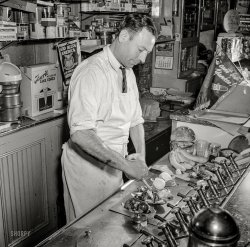
MAY CONTAIN NUTS

Search Shorpy
SHORPY ART

Framed or unframed, desk size to sofa size, printed by us in Arizona and Alabama since 2007. Explore now.
Join and Share
Ad-Free Shorpy
Shorpy is funded by you. Patreon contributors get an ad-free experience.
Learn more.

Recent comments
- Freeze Frame
- Texas Flyer wanted
- Just a Year Too Soon
- WWII -- Replacing men with women at the railroad crossing.
- Yes, Icing
- You kids drive me nuts!
- NOT An Easy Job
- I wonder
- Just add window boxes
- Icing Platform?
- Indiana Harbor Belt abides
- Freezing haze
- Corrections (for those who care)
- C&NW at Nelson
- Fallen Flags
- A dangerous job made worse
- Water Stop
- Passenger trains have right of way over freights?
- Coal
- Never ceases to amaze me.
- Still chuggin' (in model form)
- Great shot
- Westerly Breeze
- For the men, a trapeze
- Tickled
- Sense of loneliness ...
- 2 cents
- Charm City
- What an Outrage
- Brighton Park
Member Photos
The Shorpy
Print Emporium
Print Emporium
Search Shorpy
Search results -- 30 results per page
- Pat Crowe: 1921
- ... in police records under the name of Frank Roberts in Chicago, on July 5, 1890, when he was sentenced to eight years in Joliet prison ... Posted by Dave - 08/31/2012 - 8:20pm -
![Pat Crowe: 1921 Pat Crowe, "former outlaw," in 1921. According to newspaper accounts of the day, Mr. Crowe's résumé included bank holdups, train robbery and kidnapping. National Photo Company Collection glass negative. View full size.
Pat Crowe 1859-1938Famed Bandit Dies, Aged 79
[From the Daily Mail, Hagerstown, Maryland. October 31, 1938.]
Pat Crowe, the ex-convict who lectured in Hagerstown several years ago on the theme that "Crime Doesn't Pay," died Saturday in a New York hospital, aged 79.
Crowe, once sought in a nationwide hunt as the kidnaper of Edward J. Cudahy, Jr., son of the millionaire meat packer, in Nebraska in the late nineties, was taken to the Harlem Hospital last Thursday after a heart attack in his furnished room.
A man of many aliases, Crowe was one of the most colorful figures in American criminal history. Once the object of a manhunt with a price of $50,000 on his head, he later became a reformer and preached to sideshow crowds against the evils of crime.
Jewel thief, train-robber, kidnaper and burglar, Crowe first appeared in police records under the name of Frank Roberts in Chicago, on July 5, 1890, when he was sentenced to eight years in Joliet prison for robbery.
He sprang into notoriety in the kidnaping of meatpacking heir Cudahy in Omaha just before the turn of the century. A country-wide hue and cry went up for the capture of the perpetrator of the kidnaping. Posters throughout the nation screamed a then almost unheard of reward of $50,000 for his capture.
Despite intensity of the search, Crowe eluded capture. He finally surrendered voluntarily in Butte, Montana. Although he admitted the crime, Crowe was acquitted on December 18, 1900. Crowe and his confederate, Jim Callahan, received $25,000 ransom for the return of the 16-year-old Cudahy heir unharmed.
Crowe served time in many Mid-Western prisons, including a sentence in Missouri for train robbery. In 1906, after acquittal on a robbery charge, Crowe decided to mend his ways. He gave up his life as "an enemy of society," as he dubbed himself, and only once after that was arrested for any offense. That was about nine years ago on a wintry day when, broke and hungry, he was arrested for begging. He went to jail for five days.
================================
INVESTIGATION INTO DEATH OF PAT CROWE
New York, October 31, 1938. -- Police today closed an investigation into the death of Pat Crowe, 79, old-time desperado who became an evangelist. He died Saturday in Harlem hospital, apparently of heart disease.
Detectives said a fractured skull discovered in a post-mortem examination had been incurred when Crowe toppled over a banister and fell eight feet into a hallway during a heart seizure last week.
SaddleInteresting...he appears to be on a M1904 McClellan military saddle.
SaddleGood thing I checked comments first, funny enough I was going to remark on the McClellan too. Although my guess is they were fairly common around that time as refurbished/sale items from soldiers returning from duty. Perhaps not. I rode in one during a week of cavalry demos a few years ago, not so comfy for a female pelvis.
(The Gallery, Horses, Natl Photo)](https://www.shorpy.com/files/images/05583u.thumbnail.jpg)
- Gaston Street: 1939
- ... she was chilly. Or I'm just projecting October weather in Chicago onto her down in Savannah.
(The Gallery, F.B. Johnston, Savannah) ... Posted by Dave - 07/22/2012 - 2:46pm -
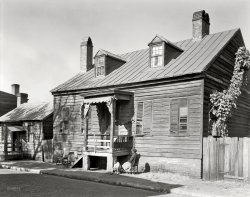
- Balcony Scene: 1925
- ... particularly lethal fires in the 40s and 50s, such as the Chicago Our Lady of Angels fire in 1958, led to much stricter building and fire ... Posted by Dave - 07/31/2012 - 2:57pm -
![Balcony Scene: 1925 Washington, D.C., circa 1925. "Stoneleigh Court." Passers-by, frozen in time. National Photo Company Collection glass negative. View full size.
One-Legged TrifectaThree one-legged ghosties in one pic.
[There are at least four one-leggers.]
A mere 57 year lifeKind of amazing at the lifespan some of these great masonry buildings had; short ones I mean. 57 years is just barely "broke in".
A Beautiful BuildingHere's more information on this great building which is now sadly gone:
http://greatergreaterwashington.org/post/2618/lost-washington-stoneleigh...
Beautiful Fire TrapsAlas, the razing of these beautiful masonry buildings had less to do with beauty and more to do with safety. A series of particularly lethal fires in the 40s and 50s, such as the Chicago Our Lady of Angels fire in 1958, led to much stricter building and fire codes being implimented in the US. For most buildings built before World War I, it wasn't financially feasible to retrofit the buildings to make them safe. Most were torn down to make way for safer, albeit uglier, structures.
WeepyAlthough I didn't "join" immediately, I've been viewing Shorpy since the beginning. You would think I would be used to finding out that the buildings we are looking at are gone. Apparently not. When I saw this one, I set to packing and calling the moving company. Vonderbees caught me just in time, and I'm sitting here in tears. Sigh. Fire hazard, whatever, they always find an excuse.
It was demolished in 1965Stoneleigh Court, completed in 1902, was home to many Washington notables over the years, including Supreme Court Justice Louis Brandeis. The view above shows the corner of Connecticut Avenue on the right and L Street NW on the left. The Blake Building went up on the site in 1966 and maintained a little hint of the Stoneleigh Court appearance.
(The Gallery, D.C., Natl Photo)](https://www.shorpy.com/files/images/SHORPY_32214u.thumbnail.jpg)
- Captured German Plane
- ... this on display at the Museum of Science and Industry in Chicago.
This is supposedly a Ju87D This is supposedly a Ju87D from a ... Posted by rkoch - 07/27/2010 - 11:02am -
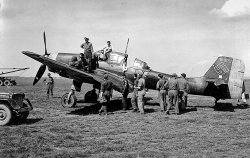
- High Roller: 1902
- ... Circa 1902. "Steel viaduct over Des Moines River, Iowa. Chicago & North Western Railway." 8x10 glass negative, Detroit Photographic ... would blow this vital rail link to get goods from Chicago out to the West coast.
(The Gallery, Boats & Bridges, DPC, ... Posted by Dave - 09/09/2015 - 10:51am -
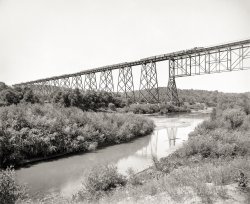
- Emporia Junction: 1943
- ... to "signalman" and "LarryDoyle". I lived by yards in Chicago and would occasionally see men at the end of trains throwing switches. ... Posted by Dave - 12/06/2014 - 1:28pm -
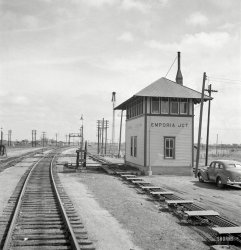
- Road Tripping: 1952
- ... the photo is what Route 66 was like most of the way from Chicago to California - a two lane concrete and/or asphalt highway.
The ... Posted by Dave - 09/02/2014 - 3:09pm -
![Road Tripping: 1952 "6 Oct 1952. Clara & Grace at chenille & souvenir shop south of _______ ." We're back with Hubert and Grace on their road trip from Minnesota, the day before our previous photo was made at Eureka Springs, Arkansas. Where are we now? 35mm Kodachrome by Hubert Tuttle; paint by Dr. Seuss. View full size.
JCT ASince the Missouri DOT doesn't have money to pave roads anymore, they have lots of time to do things like scan all of the old state highway maps. The '48/'49 and '53 maps confirm that there was never a Route T near Phillipsburg. In '49, Route T went all the way from Montreal (Missouri) to Route 66, but by '53, part of it was replaced by Missouri 35. The south end of that Route T being in Laclede County precludes there being another Route T in Laclede County that isn't connected to it.
My further guess would be that this is between Phillipsburg and Lebanon, because 1) the shadows say we are looking more or less north and 2) we can see the *backs* of signs that are advertising the wonders to be found to the south.
I spent a little time with Google Street View looking for that hill, but nothing jumped out at me. It's possible that the hill was eased when I-44 went through - the interstate would be pretty much right where Clara and Grace are standing.
How About This?Back then, the way to get from Minnesota to Eureka Springs, Arkansas was along Highway 65. Given that people in 1952 didn't travel as far in a day as we do, I'm going to guess this is around Sedalia, Missouri.
Not as rare a name as I thoughtI had thought that Wiltfong was a very rare name that might provide a location clue, but an online search shows well over 100 people with that surname. While they're located all over the place, there are a number in Missouri, which ties in with a prior comment. Someplace to the north of Eureka Springs also would make sense given the way the trees have turned more in this picture.
[What about "O. Wiltfong" -- are there hundreds of them? -Dave]
[Edit: No O's that I could find. Probably wouldn't matter, as the O in this picture has likely been long since gathered to his/her ancestors.]
[It does matter, if you're trying to figure out where this is. - Dave]
Country Roads Back when I was a lad, American highway lanes were separated by a white line (broken or solid as appropriate), as shown here. Somewhere along the line, the white of those lines was replaced with yellow, and white was retained only for separating same-direction lanes on multiple-lane roads. Apparently this was a change I completely slept through, because I can't place the time when it took place.
I wonder if anyone out there can pinpoint when this change occurred. The reason I'd like to know is that I find it irksome when "period" movies show yellow lines on putatively vintage roads (much like showing red/blue mailboxes in an era when they should be green), and I'd like to know at what portrayed period I can relax in this regard and, therefore, not feel an oppressing need to get a life.
[That bugs me in period movies, too. The change from white to yellow began in 1971 when the Federal Highway Administration assumed responsibility for the Manual on Uniform Traffic Control Devices. Everything you ever wanted to know about it is in this document. -tterrace]
I know where they are. Just outside of Hooterville.
Oliver!Oliver Wiltfong, born in 1900, was living in Blue Springs, Missouri, in 1920. In 1940, he was in St. Louis. Perhaps Ollie ended up at this roadside oddity by the time this pic was taken.
Route 66 Novelty MerchantThis is probably the home/business of Novelty Merchant Oliver U. Wiltfong in rural Lebanon area of Missouri.
Oliver (and wife Jessie) lived in rural Lebanon, Laclede County, Missouri, for about 2 years prior to Oliver's death from brain cancer on May 6, 1949.
They resided near Phillipsburg, a village of about 200 population southwest of Lebanon along U.S. Route 66 (now I-44). Postal address: Phillipsburg Rt I.
Assuming Jessie remained living in Phillipsburg after Oliver's death, at the time this photo was taken in 1952 I would venture to say this is probably the family home on Route 66 near Phillipsburg.
During the 1940/50s is was customary for folks living along Route 66 to sell novelties from their yards to passing travelers.
[The old Route 66, now State Highway W, parallels I-44 near Lebanon, Missouri, the town whose name fills in the blank in our caption. Below is Oliver's death certificate; click to enlarge. His address is given as Phillipsburg Route T, presumably State Highway T in the vicinity of Phillipsburg. - Dave]
[Dave - *Missouri T* is north of Lebanon. It runs south from Stoutland, MO to old Route 66 where it ends. Hence my conclusion the address on the Death Certificate is a U.S. Post Office mailing address (not a highway route). It's doubtful *Missouri T* ever ran all the way down to Phillipsburg, MO (unless since the 1940/50s the State renamed all the highways).
Common sense says to me that since Oliver sold novelties he would locate on old Route 66 for maximum traveler traffic. Few travelers ventured off of Route 66 particularly in rural areas (except to visit major attractions).
The building in the photo appears to be an old barn or shed dressed up a bit as a novelty shop by adding a false front and roof over hang. Notice the arched front vs. the pitched metal roof on the building; and, the double swinging barn type doors at the front of the building.
During the early to late 1950s my family traveled Route 66 annually from California to Missouri on vacations to visit family living in Missouri. The highway shown in the photo is what Route 66 was like most of the way from Chicago to California - a two lane concrete and/or asphalt highway.
The mail box with the name *O. Wiltfong* on it leads me to believe this is the property where Oliver and Jessie lived on old Route 66; and, that they converted an out building to a novelty shop.
All of this leads me to believe the photo was taken at the Wiltfong residence (and novelty shop) on old Route 66 in Phillipsburg, MO southwest of Lebanon, MO. - SilverfoxCo ]
(Minnesota Kodachromes, Travel & Vacation)](https://www.shorpy.com/files/images/SHORPY-MNK360A.thumbnail.jpg)
- Dr. Clark: 1914
- ... of New York Infirmary, and Hahnemann Medical College of Chicago. She took post-graduate work in London, Berlin and Vienna. She was ... Posted by Dave - 09/05/2012 - 1:26pm -
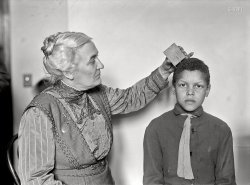
- Make It Stop: 1939
- ... were really jointly operated by three railroads. The Chicago & North Western, the Union Pacific, and the Southern Pacific.
... Posted by Dave - 04/25/2018 - 8:13am -
![Make It Stop: 1939 June 1939. West Carlin, Nevada. "Brakeman on the Union Pacific Challenger." Photo by Dorothea Lange for the Farm Security Administration. View full size.
ChallengersThe Challenger passenger trains were really jointly operated by three railroads. The Chicago & North Western, the Union Pacific, and the Southern Pacific.
The route through Carlin was off UP track, and onto the SP's. I spent some time in Carlin, not long after this shot was made, and I can tell you that the trains passing through town were almost certain to be the daily highlight to a young boy. Glad I like trains, I was.
[Our brakeman is wearing a UP uniform. - Dave]
What you write eventually was true. But, in the time of the photo, and during my youth, the shared track was owned by the Western Pacific, and only came under the UP's ownership when they absorbed the D&RGW, which had earlier gobbled up the WP. Of course, it all belongs to the UP now.
I don't know the operating arrangement, but it could well be that the UP supplied through crews for the train.
[Before Union Pacific acquired Southern Pacific in 1997, the two railroads operated separate tracks across northern Nevada. Between Weso, just east of Winnemucca, and Alazon, to the east of Elko, UP and SP operated dual trackage, with westbound traffic moving on one line and eastbound on the other. More on the Union Pacific Challenger. - Dave]
The man takes pride in his work. Vest watch, creased trousers, shined shoes, with a shave.
What is he holding in his left hand?
First Transcontinental RailroadThis man is standing on the roadbed the Central Pacific built for the transcontinental railroad, which met the Union Pacific north of Salt Lake City. Southern Pacific acquired the Central Pacific through land leasing in 1885. Union Pacific purchased Southern in 1998.
The thing in his left handThat container could be holding flares or railroad torpedoes.
Flagging KitHe's holding a standard flagging kit, the larger diameter tube in the foreground holds fusees (flares to some), the smaller diameter tube on the far side holds the flag when not in use. Like many trainmen, he has wrapped a number of track torpedoes (explosive devices that make a very loud sound when a train rides over them, but don't damage the track or wheel) on the smaller tube to make them easy to get to.
Challengers of Two TypesThe Union Pacific had both passenger trains and locomotives called Challengers. As far as I know, the two were not necessarily associated with each other. A Challenger (locomotive) might pull a Challenger (passenger train) over part of the trip.
Length of serviceWould the three bars on his sleeve indicate the length of service on the UP?
(The Gallery, Dorothea Lange, Railroads)](https://www.shorpy.com/files/images/SHORPY-8b33533a.thumbnail.jpg)
- Behemoth: 1943
- January 1943. "Freight operations on the Chicago & North Western between Chicago and Clinton, Iowa. The crew, with exception of the fireman, chat while ... Posted by Dave - 12/10/2014 - 9:40am -
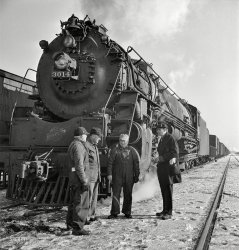
- Men's Furnishings: 1959
- ... look good. Used to make a trip to Carson Pirie Scott on Chicago’s State Street about every other week to buy a few while going to ... Posted by Dave - 08/08/2013 - 3:32pm -
![Men's Furnishings: 1959 Oct. 23, 1959. "Bloomingdale's. Hackensack, New Jersey. Men's shop. Raymond Loewy, client." Large-format negative by Gottscho-Schleisner. View full size.
The more things change ...The suits on the mannequins are still very much in style today, as are the plaid shirts to their right. Even the hat on the mannequin has come back into style after many years in the wilderness (so to speak) thanks to hipsters.
Ah! Room To Move Around!So much space! You can actually walk around without bumping into a rack or another shopper. Today's stores try to cram so much into so little space; it's a wonder clothes are on the floor being stepped on, not to mention other shoppers stepping on my toes. I remember stores like this: Robert Hall, Alexanders, Gertz etc. - they were a pleasure to shop in.
Reminds MeOf Raleigh Haberdashers. Long gone and still fondly remembered.
English tab collarsThe guy on the left is sporting an English style tab collar on his shirt. They were my favorites in the late 50s because no matter how badly I made my necktie knots, the tab collar always made them look good. Used to make a trip to Carson Pirie Scott on Chicago’s State Street about every other week to buy a few while going to school there in 1959/1960. These shirts are still available online.
BloomiesBloomies were so well dressed in 1959, even their furniture wore bow ties.
Loewy?What is the reference to industrial designer R. Loewy?
[Gottscho-Schleisner was working on commission from Loewy. -tterrace]
[Whose firm designed the interior seen here. - Dave]
Everything looks goodexcept that the visual people buttoned the bottom button on the jacket on the mannequin on the left; always was and always will be a sartorial no-no. One can see the slight beginning of pulling through the hips that this will inevitably cause. Please don't do it.
(The Gallery, Gottscho-Schleisner)](https://www.shorpy.com/files/images/SHORPY_5a27086u.thumbnail.jpg)
- Grease: 1925
- ... Ohio; Atlantic City and Woodbridge, New Jersey, Charlotte, Chicago, Des Moines, Miami, Omaha, and Tacoma, plus Kansas City, Missouri; ... Posted by Dave - 10/22/2012 - 10:54am -
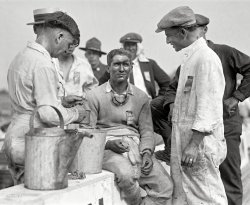
- The Traveler: 1939
- ... View full size.
C&EI Hrm. Most likely the Chicago & Eastern Illinois tracks, though it might be a short line still in ... Posted by Dave - 02/23/2017 - 7:06pm -
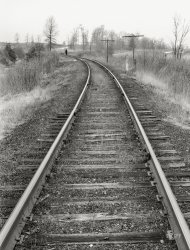
- Old Paint: 1920s
- ... many years ago. The photographer, Stadler, was based in Chicago. Where are you now, Nu-Enamel boys? View full size.
Still With ... Posted by John.Debold - 12/15/2016 - 11:31pm -
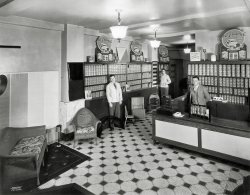
- Amarillo Yardmaster: 1943
- ... in both east and westbound moving along the system between Chicago and New York.
There was always a saying in our home that when we ... Posted by Dave - 08/10/2012 - 4:15pm -
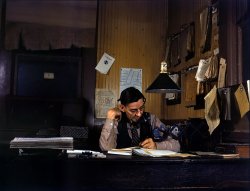
- Radio Highlights: 1957
- ... Brahms, and Bizet.”
Washington Redskins versus Chicago Bears and Baltimore Colts versus Los Angeles Rams
“Fact the ... Posted by Dave - 06/02/2017 - 12:50pm -
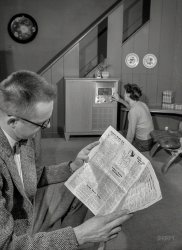
- Cow Town: 1943
- ... I assume) would be making a short stop on the way to Chicago on trip to promote buying War Bonds. My grandfather, a then-retired ... Posted by Dave - 09/05/2012 - 6:07pm -
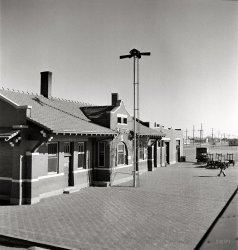
- George and Gracie: 1955
- ... it, Gracie said "George got it for me after he went to Chicago on a business trip. He had a brief affair and felt so guilty that he ... then Gracie said, "I hope George goes back to Chicago this year. I could really use a new car."
Looking Ahead Who'd ... Posted by Dave - 06/17/2019 - 1:02pm -
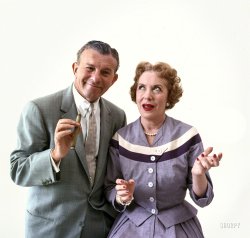
- Along the River: 1905
- ... the Northern Steamship Company between Buffalo, N.Y., and Chicago, Ill. The steamer called at Cleveland, Ohio, Detroit, Mackinac Island, ... Posted by Dave - 12/12/2012 - 1:03pm -
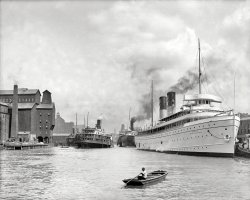
- Behind the Gray Door: 1925
- ... only for thirty. Louis Armstrong had left in '22 for Chicago. I'm not sure of the exact location, but the stone and brick are ... Posted by Dave - 01/12/2015 - 12:39pm -
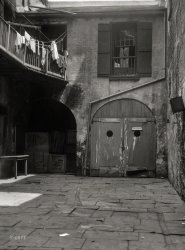
- Peeps and Pup: 1900
- ... was a Dudley Walker who was advertising manager for the Chicago and Alton Railroad at the turn of the century.
His house, designed ... *foot* negatives, built in order to photograph one of the Chicago and Alton's newest trains as one single shot as opposed to a series of ... Posted by Dave - 07/09/2014 - 1:59pm -
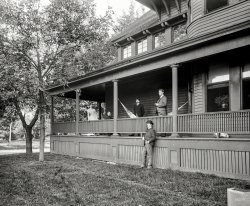
- Cuyahoga Lift Bridge: 1910
- ... and moves easily, are underground, like the ones on the Chicago River.
This is a Scherzer Rolling Lift Bridge known as Baltimore ... Posted by Dave - 10/13/2018 - 10:36am -

- Frank Chance: 1910
- Chicago Cubs first baseman Frank Chance. December 16, 1910. View full size. ... Posted by Dave - 07/29/2012 - 7:10pm -
![Frank Chance: 1910 Chicago Cubs first baseman Frank Chance. December 16, 1910. View full size. Gelatin silver print by Paul Thompson.
Incorrect date?It's unlikely the photos of Evers and Chance (who knows where Tinkers was?) were taken in December. Both ballplayers are in uniforms, such as they were in those days, and they obviously were shot in a ballpark, probably in a dugout, judging from the wood in the background.
But not in December. Major League baseball in the Tinkers-to-Evers-to-Chance era ended in September, and there were no winter leagues as there are now. So by December, these guys were back at their regular occupations, working in hardware stores or on the farm or whatever. Judging from their faces, whatever work they did was hard, and it was unlikely they were doing American Express commercials.
[Most of these pictures were taken in December 1910 and January 1911 for American Tobacco Co. baseball card issues, including Gold Borders (T205) and Triple Folders (T202). - Dave]
Baseball photosThese were part of a set of about two dozen pictures, most of them taken in December 1910 and January 1911, for American Tobacco Co. baseball cards.
Still sounds unlikely to meStill sounds unlikely to me, Dave. Maybe the ballpllayers were shot during the season, and the cards issued in December to keep interest alive?
In any case, extraordinary photos. Many thanks for posting them.
The pictures were shot during the winter (which is why Christy Mathewson is wearing that big sweater) and the cards came out in the spring. If the Library of Congress and the photographer's caption info are to be believed. - Dave]
1911 Spalding GuideThese photos were also used in the 1911 Spalding Guide.
(The Gallery, Paul Thompson, Sports)](https://www.shorpy.com/files/images/13533u.thumbnail.jpg)
- South by Southwest: 1943
- March 1943. Melrose, New Mexico. Chicago to California trip. "Santa Fe R.R. train." View full size. 4x5 ... Posted by Dave - 08/10/2012 - 7:50pm -
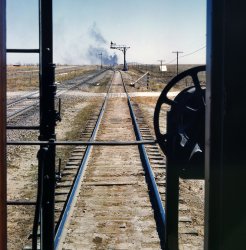
- Skating Masquerade: 1906
- ... …
The Richardson Ball-Bearing Skate Company, of Chicago, has recently sold to Manager Louis Shouse, of the Kansas City ... Posted by Dave - 08/08/2012 - 3:12pm -
![Skating Masquerade: 1906 Kansas City, Missouri, circa 1906. "Convention Hall." For four days only, a "Grand Skating Masquerade." 8x10 glass negative, Detroit Publishing Co. View full size.
It was rebuilt in 90 days!The original Convention Hall that was built on 13th at Central Street in 1899 was destroyed by fire on April 4,1900. The Democratic National Convention was scheduled there over July 4. So this replacement "fireproof" structure was designed and built in 90 days using some parts of the old shell that were still sound. The convention was held as scheduled (with 16-year-old Harry Truman serving as a page boy) and nominated William Jennings Bryan. The Republican National Convention was held there in 1928 and nominated Herbert Hoover. The Convention Hall was demolished in 1936.
Richardson Ball-Bearing Skates
The Billboard, Oct 31, 1908.
Skating Rink Notes and News
By Earle Reynolds.
…
The Richardson Ball-Bearing Skate Company, of Chicago, has recently sold to Manager Louis Shouse, of the Kansas City Convention Hall, a large consignment of Richardson Ball-Bearing Rink Skates. Manager Shouse expects to open his big rink a few days after election. The Convention Hall will be artistically decorated and made into one of the finest rinks in the country. Manager Shouse is a past master in the amusement business and has been a successful rink manager for a number of years. He has played all the leading skating attractions in the country including Chas. L. Franks, Nellie Donegan, the Famous Rexos, and a number of others. He will play many P.E.R.S.A. [Professional Roller Skaters' Association] acts the coming season, in addition to running a series of national championship races.
…
Hardware Dealers' Magazine, 1904.
Barney Allis PlazaI work across the street from this site. The building was demolished in 1936 and is now an underground parking garage with a park above. Barney Allis Plaza (as it is now known) has tennis courts, outside seating, fountains and hosts events throughout the year.
Delightfully informativeThis simple posting of a convention center in KC is a classic example of how delightfully informative this website can be. Look at what we can learn:
1) site was rebuilt for the Demo convention of 1900
2) roller skating in this era was both personal recreation and professional shows ("Skating on Wood"?)
3) we get the chance to compare "before" and "after" views of our world - I like to use Google Maps to find a street view.
This location was only about a mile east of the stockyards, which explains the industrial, and somewhat unclean surroundings. A present-day view shows substantial urban renewal - with a modern convention center.
(The Gallery, DPC, Kansas City MO)](https://www.shorpy.com/files/images/4a13238a.thumbnail.jpg)
- Knock Knock: 1943
- ... operations on the Indiana Harbor Belt railroad between Chicago, Illinois and Hammond, Indiana. Locomotive coupled to caboose." Photo ... Posted by Dave - 10/07/2013 - 12:24pm -
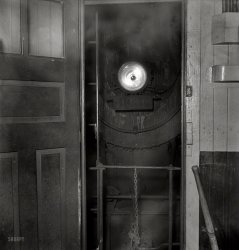
- Sheetsville: 1941
- ... Pennsylvania Railroad's "Broad Way", used by their NYC to Chicago "Broad Way Limited" luxury passenger train. That train passed here on ... Posted by Dave - 11/04/2017 - 1:59pm -
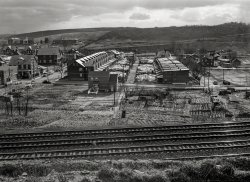
- Westbound Freight: 1943
- ... of War Information in March 1943, riding a freight from Chicago to California. Most of them were in black-and-white. He used a Graflex ... I hope we can see all of Jack's pictures he took from Chicago to LA
(The Gallery, Kodachromes, Jack Delano, Railroads) ... Posted by Dave - 08/05/2012 - 9:30am -
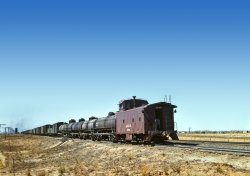
- Broughton Street: 1905
- ... 2010.
Transitional architecture anomaly After the Chicago Fire in 1870, the Chicago School of architecture, especially Louis Sullivan, pioneered new ... Posted by Dave - 05/09/2019 - 10:33am -
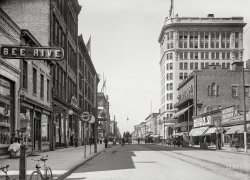
- Bananamerica: 1942
- ... it while having a limeade.
Split Decisions I'm from Chicago, and at the Dairy Queen my parents took my sister and I to sometimes ... Posted by Dave - 09/18/2017 - 4:17pm -
